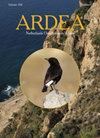从Bosporus到Kopet-Dagh:土耳其、高加索和土库曼斯坦西部Chiffchaff的形态、遗传和生物声学变异
IF 1.3
4区 生物学
Q3 ORNITHOLOGY
引用次数: 0
摘要
Chiffchaff超物种复合体几乎占据了整个古北极地区,包括许多不同级别的分类群。传统上,这被认为是古北极鸟类分类学中最复杂的问题之一。我们提供了关于在土耳其、高加索、外高加索和Kopet-Dagh发现的Chiffchaff分类群的遗传学、形态学和生物声学的新数据:“绿色”的短吻龙、高加索龙、门氏龙和“棕色”的洛伦兹龙。在土耳其南部,发现了两个Chiffchaff,它们携带一种新的单倍型,最近在以色列北部发现。这两个来自土耳其的人看起来都比典型的短吻鳄更明亮、更淡黄色,但他们的歌曲显然与短吻鳄方言相对应。短吻龙栖息在土耳其北部的西部和中部地区,由于其体型小、翅膀形状和独特的声乐方言,被发现是所有“绿色”分类群中最独特的。矛盾的是,短吻龙的线粒体DNA与高加索龙几乎相同,而在这方面,门氏龙与两者不同。我们相信,如果我们假设高加索起源于短吻龙和门兹比里的古代杂交,就可以解释这种悖论。在土耳其东部山区,短吻龙和洛伦兹龙之间的关系表明,一些个体的表型和基因型性状不匹配,这也可能是杂交的结果。本文章由计算机程序翻译,如有差异,请以英文原文为准。
From the Bosporus to Kopet Dagh: Morphological, Genetic and Bioacoustic Variation in the Chiffchaff in Turkey, the Caucasus and Western Turkmenistan
The Chiffchaff superspecies complex occupies almost the entire Palearctic and includes many taxa of different ranks. It is traditionally considered to be one of the most complex problems in the taxonomy of Palearctic birds. We present new data on the genetics, morphology and bioacoustics of the Chiffchaff taxa found in Turkey, the Caucasus, Transcaucasia and Kopet Dagh: ‘greenish' brevirostris, caucasicus, menzbieri and ‘brownish' lorenzii. In southern Turkey, two Chiffchaffs were identified which carried a novel haplotype, recently discovered in Northern Israel. Both individuals from Turkey looked somewhat brighter and more yellowish than typical brevirostris, but their song clearly corresponded to the brevirostris dialect. The form brevirostris, inhabiting the western and central regions of Northern Turkey, was found to be the most distinct among all ‘greenish’ taxa, due to its small body size, wing formula and distinct vocal dialect. Paradoxically, the mitochondrial DNA of brevirostris is almost identical with caucasicus, whereas, in this respect, menzbieri is different from both. We believe that this paradox can be explained if we suppose that caucasicus originated during the ancient hybridization of brevirostris and menzbieri. The relationships between brevirostris and lorenzii, in the mountainous regions of eastern Turkey, show the mismatch between phenotypic and genotypic traits in some individuals that could also be a result of hybridization.
求助全文
通过发布文献求助,成功后即可免费获取论文全文。
去求助
来源期刊

Ardea
生物-鸟类学
CiteScore
2.10
自引率
0.00%
发文量
49
审稿时长
>12 weeks
期刊介绍:
Ardea is the scientific journal of the Netherlands Ornithologists'' Union, and is published since 1912. The journal welcomes manuscripts reporting significant new findings in ornithology, in particular those covering the ecology, life history, and evolution of birds, and including sound descriptive work. Ardea publishes Original research papers, Short notes and Book reviews. In addition to the regular three issues per year, Ardea publishes specials that contain conference or workshop proceedings (produced on request).
 求助内容:
求助内容: 应助结果提醒方式:
应助结果提醒方式:


